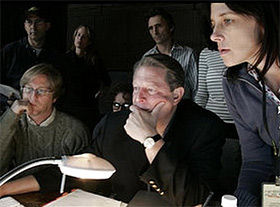 |
 |
 |
 Entertainment | January 2006 Entertainment | January 2006  
Al Gore, Sundance's Leading Man
 William Booth - Washington Post William Booth - Washington Post


| | Hours before the filming of "An Inconvenient Truth," former vice president Al Gore works with a team to choose the best from among 400 slides and animations from his environmental show. (Participant Productions) |
Has ever a little indie film faced a greater hurdle? Imagine this sales pitch: Babe, it's a movie about global warming. Starring Al Gore. Doing a slide show.

With charts.

About "soil evaporation."

Improbable? Perhaps. So it's all the more amazing that "An Inconvenient Truth" had its world premiere at the Sundance Film Festival on Tuesday night before an enthusiastic audience that gave the former vice president and his movie a big standing O.

Among the film's lessons: Earth's glaciers are melting, the polar bears are screwed, each year sets new heat records. Al Gore sometimes flies coach. He also schleps his own bags.

The morning after his debut as leading man, Gore pronounces this whole Sundance thing "a most excellent time." He is wearing earth tones again. He seems jolly . He brought Tipper and the kids. He is attending parties and posing for pictures with his fans and enjoying macaroni and cheese at the Discovery Channel soiree. He's palling around with Larry David of "Curb Your Enthusiasm," who says, "Al is a funny guy." But he is also a very serious guy who believes humans may have only 10 years left to save the planet from turning into a total frying pan.

The core of the film is a one-man, ever-evolving multimedia slide show that Gore assembled himself. A little-known fact: Since his defeat by George W. Bush in 2000, Gore has traveled the globe with his bar graphs, staging event after event for small, invited audiences. Free of charge. And he's presented one version or another of this slide show, by his own estimation, a thousand times.

The official Sundance Film Festival guide calls the documentary a "gripping story" with "a visually mesmerizing presentation" that is "activist cinema at its very best."

In the film, Gore presents the latest evidence to demonstrate how the accumulation of carbon dioxide and other pollutants of the industrial age are increasing temperatures. In addition to timelines and bell curves and stuff about oxygen isotopes in Greenland ice cores, Gore includes several cartoons, one featuring a Mister Sunbeam trapped by the bullies known as Greenhouse Gases.

Gore argues - with scientific evidence projected on big screens at his back -- that global warming may soon lead to catastrophic sea level rises, which could inundate cities such as New York (flooding the former site of the World Trade Center), producing scary nonlinear runaway spasms of extreme weather (bigger, badder hurricanes and typhoons), global pandemics and, depending on where you live, torrential rains or decade-long drought. It is not a pretty picture.

But the film's director, Davis Guggenheim (husband of actress Elisabeth Shue), captures another side of Gore, showing the former veep hitting the road, part Cassandra, part Willy Loman, working out of dreary hotel rooms, pecking away on his Apple laptop, crisscrossing the continents to tell his story over and over.

"I'm interested in choices characters make, especially when they hit against an obstacle," says Guggenheim as Gore sits beside him during an interview yesterday morning. "As I got into Al's story, I see a human being who's made some tough, tough choices in his life. After the 2000 election? To go back deeper and deeper into this issue? To decide that it is the most important thing he can do. . . . I see how tireless he is. That, to me, is so dramatic, so inspiring."

The film touches briefly but with emotion on three events in Gore's life and how they inspired his environmental activism: the car accident that almost took the life of his son; his defeat in Florida to Bush; and perhaps most foreboding, the death of his sister, a lifelong smoker, from lung cancer ("That's not one of the ways you want to die," Gore says in the film in a voice-over) and the fact that his family farmed tobacco and didn't stop until after her death. Gore underscores that this is the way people are, that it is hard to change old habits, be it smoking or growing tobacco or emitting carbon dioxide, but that without change, the bell tolls.

The film came about after Laurie David, wife of Larry David, saw Gore's slide show in New York after the 2004 premiere of the mega-budget global-warming feature film "The Day After Tomorrow" (starring Dennis Quaid and Jake Gyllenhaal). Laurie David gathered a team, including Lawrence Bender (producer of Quentin Tarantino films, including "Pulp Fiction") and Jeffrey Skoll, the billionaire eBay founder and movie mogul. They met with Gore. "We said you have to let us make this into a movie," David says in an interview over breakfast.

It took some convincing. The slide show, she says, "was his baby, and he felt proprietary about it and it was hard for him to let go." Now, David says, the filmmakers are in discussion with three or four distributors, hoping for a sale.

"This isn't about box office," David says. "None of us are going to make a dime." What is at stake, she says, "is, you know, the planet." | 
 | |
 |



